You get three steps before you must pass or shoot
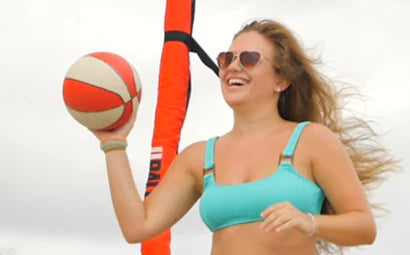
You can go behind the hoop like hockey or lacrosse
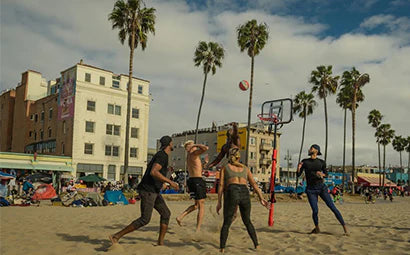
Half court shots are two points (20 feet from basket)
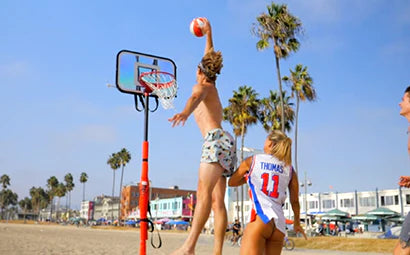
Player Count: 2 on 2
Teams must take the ball back on every change of possession. Set take-back marker 20ft from basket.
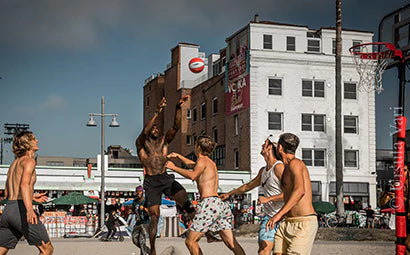
Player Count: 3 on 3
Game begins with tip-off
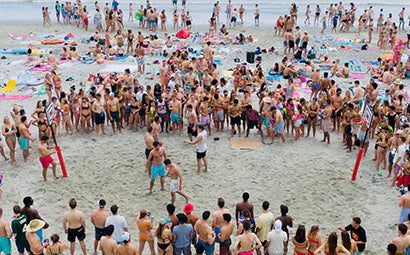
OFFICIAL UBALL RULE BOOK
Section 1: Basket & Backboard
A. The “basket” of a team is the structure formed by the rim, net, backboard and supporting pole. The rim of the basket is the ring that a player attempts to shoot the ball through.
B. The visiting team chooses the basket it wishes to defend in the first half. The teams will change baskets in accordance with Article VI, Section 1.
C. All sides of the backboard are considered in play and in-bounds.
Section 2: Pass
A “pass” constitutes the exchange of ball possession between teammates. A pass can be made by any means, including by hand, foot, body or head. Inadvertent contact shall not be considered a pass, nor shall any ball strike that is not intended to transmit the ball directly to a teammate.
Section 3: Loose Ball
A loose ball means that neither team has possession and each team has an equal right and opportunity to obtain possession. Possession is demonstrated by maintaining full control of the ball in a player’s hands. Any ball in the air (other than a shot) or on the ground is considered a loose ball.
Section 4: Fouls
A. A personal foul occurs when there is illegal physical contact with an opponent during a live play. Any foul occurring after a stoppage of play or expiration of time should be disregarded. Unsportsmanlike conduct can be penalized by a foul both during play and after any stoppage of play.
B. A loose ball foul occurs when a player makes illegal contact with his opponent when neither team has possession.
C. A foul occurring in the act of shooting will be called even if occurring after time has expired, if the shot was released prior to the expiration of time.
D. An offensive foul is a personal foul committed by a player on the offensive team while the offensive team has possession of the ball.
E. A double foul occurs when two opposing players commit personal fouls approximately at the same time.
F. A flagrant foul is excessive contact committed by a player against an opposing player at any point during or after the game.
Section 5: Field Goal Attempt
When a player attempts to shoot the ball into the basket, this is considered a “field goal attempt”, which includes the flight of the ball until touched or dead. In the official’s sole judgment, the act of shooting begins when the player starts his shooting motion and continues until the ball is released and the player re-establishes position on the playing surface. On moving shots toward the basket, the motion of shooting starts when the shooter positions the ball in his/her hands to begin the shooting motion. The ball does not necessarily have to leave the shooter’s hands as long as the shooter demonstrates an intent to shoot the ball. In order to count as a score, the ball must be released prior to expiration of time AND it must go through the ring of the rim and the net.
Section 6: Pivot
A player may pivot with the ball by establishing a stationary foot (plant foot) and moving only the other foot from spot to spot. Failure to maintain a stationary plant foot will constitute traveling. A player may only move his/her plant foot if possession is disrupted by his/her opponent. Throwing a ball off of an opponent to regain possession will not allow pivoting player to move his/her plant foot.
Section 7: Traveling
Traveling occurs when player takes more than two steps while in possession of the ball. In addition, if a player jumps in the air and before releasing the ball (via pass or shot), lands on the ground, a travel will be called.
Section 8: Check-In/ Check-up
A check-up is used to resume play after a form of a stoppage of the game. All check-ups occur at the middle of the court/playing field (the same location as the tip-off). A check-up is performed when the offensive player passes the ball to a defender, who checks to make sure that the remaining defenders are prepared to start, then passes the ball back to the offensive player. The game resumes as soon as the offensive player catches the ball. The purpose of a check-up is twofold:
1. To resume the game in a fast/timely manner
2. To allow the defense to get prepared
Section 1: Dimensions of Court
A. The size of the court/playing field is 40 feet (measured from pole to pole) for full-court regulation games
a. A half court is played 20 feet long from pole to a take-back line
b. There is no out of bounds
Section 2: Equipment
A. Games shall be played with an official Uball-approved basketball having a diameter of 25.5 inches.
B. The ball shall be inflated between 7.5 and 8.5 pounds per square inch.
C. The backboard shall be 33 inches in length and 23.5 inches in height with a flat, transparent surface.
D. The backboard shall be marked with a shooting box in the center of the backboard. The box shall be in the form of a rectangle measuring 14 inches on the horizontal sides and 11.5 inches on the vertical sides. The bottom horizontal line shall be positioned immediately above the rim plate with the rim centered along the bottom horizontal line.
E. The home team is required to have a fully configured backup Uball set in the event the game equipment is damaged.
F. The rim of the basket shall be a detachable Uball-approved rim that is 15 inches in diameter (measured from the inside). A net that is 18 inches in length shall hang from the rim. The net shall be made of white cord ranging between 30 thread and 110 thread.
G. The rim of the basket shall be set at 8.5 feet above the ground (measured from the ground to the top of the rim). The rim shall protrude from the backboard exactly 5.5 inches (measured from the flat portion of the backboard surface to the outer part of the rim). The rim shall be painted red.
H. Shoes are not required but would be recommended on fields
I. Matching uniforms are required
a. Each player must have a number on his/her uniform. No two players can
wear the same number.
b. Pants/shorts do not have to match the uniform or match those of other
teammates.
J. Other clothing or accessories such as headbands, medical braces, or arm/leg sleeves are permitted
K. Any clothing or accessories that could be threatening, possibly dangerous, or otherwise provide an illegal advantage (i.e. weapons, jewelry, or wristwear) are not permitted
Section 2: Equipment
A. Games shall be played with an official Uball-approved basketball having a diameter of 25.5 inches.
B. The ball shall be inflated between 7.5 and 8.5 pounds per square inch.
C. The backboard shall be 33 inches in length and 23.5 inches in height with a flat, transparent surface.
D. The backboard shall be marked with a shooting box in the center of the backboard. The box shall be in the form of a rectangle measuring 14 inches on the horizontal sides and 11.5 inches on the vertical sides. The bottom horizontal line shall be positioned immediately above the rim plate with the rim centered along the bottom horizontal line.
E. The home team is required to have a fully configured backup Uball set in the event the game equipment is damaged.
F. The rim of the basket shall be a detachable Uball-approved rim that is 15 inches in diameter (measured from the inside). A net that is 18 inches in length shall hang from the rim. The net shall be made of white cord ranging between 30 thread and 110 thread.
G. The rim of the basket shall be set at 8.5 feet above the ground (measured from the ground to the top of the rim). The rim shall protrude from the backboard exactly 5.5 inches (measured from the flat portion of the backboard surface to the outer part of the rim). The rim shall be painted red.
H. Shoes are not required but would be recommended on fields
I. Matching uniforms are required
a. Each player must have a number on his/her uniform. No two players can
wear the same number.
b. Pants/shorts do not have to match the uniform or match those of other
teammates.
J. Other clothing or accessories such as headbands, medical braces, or arm/leg sleeves are permitted
K. Any clothing or accessories that could be threatening, possibly dangerous, or otherwise provide an illegal advantage (i.e. weapons, jewelry, or wristwear) are not permitted
Section 1: Team/PlayersA. There are 3 players on each team. A team is also permitted one substitute, but at no time may there be any more than 3 players on the court during game play.
B. Each team shall provide the scorer with a starting lineup at least 10 minutes before tip-off.
C. A substitute must report to the scorer’s area and request entrance to the game. He/she may only enter the game upon a game stoppage and the permission of the game official to enter the court. The game official shall have sole discretion to permit a substitute to enter the game.
D. A substitute will be treated as a participant in the game once the game official gives him/her permission to enter the court. A substitute must remain in the game for a minimum of one live ball play--running from the game official’s commencement of game play until the stoppage of play for any reason.
E. No substitutes will be permitted to enter the game after a made basket by either team unless a time out is granted by the game official or in the event of personal foul.
Section 2: CoachesA. Teams may elect to have a coach, but having a coach is not mandatory. The coach can be either a player or an individual who is not a member of the team. If the coach is not a member of the team, he/she must be designated in advance of the start of a game and must continue to function in that role for the duration of the game. No more than one coach is permitted.
B. The coach must remain within 10 feet of the players’ area, but is not permitted under any circumstances to physically interfere with game play. If a coach intentionally interferes physically with game play, the team will be assessed a technical foul.
C. A player-coach has no special privileges. While playing, he/she will be treated as a player and, while not playing, will be treated as a coach.
A. There shall be a total of two officials: the Game Official and the Official Scorekeeper.
B. Game officials shall wear the designated Uball-approved uniforms.
C. Game officials are solely responsible for ensuring that the game is played fairly and legally. A game official’s judgment on rules and fair game play shall be final, unless a blatant error can be demonstrated. If game rules are not followed, game officials have the authority to call fouls and assess penalties as prescribed in these rules.
D. If a coach wishes to discuss a ruling or any official’s decision, the official must bring the other team’s coach into the discussion to ensure an open forum. The game official shall have sole discretion as to whether he/she wishes to entertain the coach’s inquiry. A coach may only seek a ruling clarification during a stoppage of play. The game official can assess a technical foul on a coach that improperly seeks to discuss a ruling decision with a game official.
E. Prior to the start of the game, the officials shall inspect all equipment, which includes each team’s designated basket and the basketball structure of each designated basket.
F. Game officials will not permit any jewelry or other objects to be worn by players that could present a safety hazard.
G. The game official must check the ball to ensure that it is of appropriate quality for game play and that it is properly inflated. Proper inflation is between 7.5 and 8.5 pounds per square inch.
H. Prior to the start of the game, the game official shall confirm that the court/playing field dimensions comply with all prescribed rules.
I. Gloves are permitted, but no tacky substances of any kind are permitted. Officials shall remove any player from the game if such substances are discovered. A player shall not be permitted to re-enter the game until the substance(s) have been fully removed.
J. The designated game official shall toss the ball at the opening tip and any other jump ball challenges.
K. The Official Scorekeepers shall:
a. Maintain a record of the names and jersey numbers of each team’s players. b. Record all field goals made and missed. c. Keep a record of each individual player’s statistics for shot attempts, shots made, rebounds and assists. d. Tally each team’s total personal fouls, including the number of personal fouls on each player. e. Maintain an official status of the change of possession arrow. f. Keep track of the official game score. g. Control the official game clock, which includes clock stoppages during timeouts and any intermission periods.
Section 1: Tip-offs
A. Games shall be started with a tip-off in the center of the court/field.
B. Players participating in the tipoff may not touch the ball before it reaches the apex of its toss.
C. Players may tip/hit the ball in any direction.
D. Players may line up anywhere they wish for the tipoff, except for directly behind the opposing team’s player who is tipping.
E. Treatment of jump balls:
1- The ball must be tapped by one of the jumpers after it reaches its highestpoint. Neither player may tap the ball before it reaches its apex. If the ball falls to the ground untapped, the game official will execute another jump ball. 2- Neither player involved in the jump ball can take possession of the ball untilanother player has touched it.Section 2: InboundingA. After a successful field goal, players shall bring the ball back in play by a inbounds play/throw in.
a. A legal throw in requires the player to have both feet behind the baseline or the imaginary line that is connected to the pole of the hoop and runs parallel to the backboard as depicted.B. Players are allowed to take two steps but the steps must be parallel to the baseline.
C. Those defending the throw in may not cross the baseline, whether it be stepping across or even reaching across.
D. In the event that the ball enters the rim from the bottom on an inbounds play, the ball is given to the defense for a check-in at half court.
E. Players shall have five seconds from the time from when they first establish two feet behind the baseline to when they release the ball.
a. If they do not inbound in the ball in the five seconds, a five-second violation shall be called and possession will be awarded to the defense via a check in.Section 3: Live BallA. The ball is alive after a tip-off, a check-in, or retrieval by a player on the opposing team of a made shot on their basket. After a made basket is retrieved by the opposing team’s player, the player will be given sufficient space by the other team to make a first pass to a teammate in accordance with Section 1 above.
B. After any dead ball, play shall resume with a jump ball or a check-in.
C. On any rules infraction, possession will be granted to the opposing team via a check-in.
EXCEPTIONS:1- Clear path foul: Point awarded
Section 1: Duration of Game
A. Regulation play shall continue until the winning team scores 11 points. There is no “win by 2” rule.
B. When the first team reaches 6 points, the teams shall change baskets.
Section 2: Timeouts
A. Teams are allowed two timeouts per game.
B. Timeouts will last 60 seconds.
C. In order to call a timeout, the team must have possession of the ball.
D. Timeouts can be called by verbally calling “Timeout” or by making the timeout symbol with hands.
E. Both players and coaches are permitted to call timeout.
F. After a timeout, teams shall have the opportunity to insert a substitute player.
G. Timeouts may be called at any point to readjust the hoop.
a. There are unlimited timeouts for hoop adjustments.
b. Timeouts for hoop adjustments shall be no more than 10 seconds.
Section 3: Scoring
A. A field goal shall be counted as successful if it passes through the circle of the rim and through the net.
a. If the ball does not pass through the net, there is no score.
B. A successful field goal can be accomplished by either a shot, layup, or dunk.
a. For safety purposes, as well as for the functionality of the Uball set,
players are not allowed to hang on the rim, especially after dunks.
b. If a player hangs on the rim after a dunk, the basket will be disallowed
and possession will be awarded to the opposing team.
C. Players may not use the rim, pole, or backboard to raise themselves while
scoring.
a. These actions will result in a turnover.
D. Each successful field goal counts as 1 point.
E. Field goals may be shot from anywhere, including behind the basket.
Section 4: Gameplay
A. Players may take two steps, then must either pass or shoot.
a. Dribbling does NOT permit a player to take more steps.
b. If a player takes more than 2 steps, a travel is called and results in a turnover
B. There are no out of bounds areas.
a. If the ball leaves the immediate playing field, players must keep playing and retrieve the ball.
b. If the ball enters the substitute players’ area or coaches area, play will continue unless the substitute players or coaches interfere with game play. If the interference is unintentional, then play will stop. In that instance, the team with possession shall receive a check-in to resume play. If interference is intentional, the interfering team shall receive a technical foul. If the technical foul is on the offensive team, then possession shall be granted to defensive team. If the technical foul is on the defensive team, possession shall remain with the offensive team.
C. If a player passes or shoots the ball and it does not hit the rim, backboard, or another player, then that player is not allowed to be the first person to touch the ball.
a. If that player is the first to touch the ball, it is a turnover.
D. A player is permitted to throw the ball at the backboard and retouch the ball without it first being touched by an opposing player. For example, a player can throw the ball off of the backboard like an alley-oop shot, re-catch it and complete a slam dunk.
E. In order to benefit the flow of the game, zone defense is prohibited. Players must play man-to-man defense at all times.
F. A held ball shall be called when players on both teams have a firm grasp of the ball, and there is a risk of injury.
a. When a held ball is called, the two players involved will have a jump ball in the same spot where the call was made.
G. Players may set screens on defenders under the following conditions:
a. The screener is motionless at the point of impact; and
b. The screen is set in a non-threatening manner to the defender
H. If the screener’s feet are not set or are in any way moving at the point of impact, a moving pick will be called and will result in a turnover.
I. If a player should drop or fumble the ball, it is not a turnover, but rather becomes a loose ball.
J. Players may be physical when the ball is loose. Slight pushing or hip checks are permitted but any excessive or flagrant contact will result in a personal foul and possession for the team that was fouled.
K. Players may use their feet to push the ball forward or pass to a teammate.
a. Any excessive kicking that is done with the intent to kick someone rather than the ball will result in the opposing team receiving possession.
L. There are no backcourt violations. The ball can travel from both ends of the playing court/field at any time without any restrictions.
M. Players are permitted to play behind the basket, including for purposes of shooting rebounding, passing, or defending.
N. Players are prohibited from grabbing the pole while in play.
EXCEPTION: Players may touch the pole when the hoop needs to be readjusted.
Section 6: Basket Interference - Goaltending
A. Players may not block or contact a shot if it is in its downward ascent towards the rim.
B. Players may not reach through the bottom of the rim to block any shots.
C. Players may not block a shot that has contacted the backboard and is proceeding towards the hoop, regardless of whether the ball is in the process of ascending or descending.
D. Players may not hit the rim or backboard while a shot is proceeding towards the rim causing the rim to vibrate, which may otherwise cause an unnatural bounce.
E. Players are allowed to block a shot against the backboard as long as the hand of the defender makes contact with the ball either before or as the ball contacts the backboard.
F. Once the ball strikes the rim, any player can play the ball (i.e. swat it away or tap it in), even if the ball is within the cylinder of the hoop.
A. To aid the flow of the game, only blatant shooting fouls and technical/flagrant fouls shall be called.
B. When a foul is called, the team fouled shall restart with the ball at half court for a check-up.
C. When a player has a clear path to the basket, and the defender fouls simply to stop the offensive player from scoring, a point is counted.
D. Excessive swinging of elbows is not allowed, even if no contact is made with a defender.
a. Excessive swinging of elbows will result in a technical foul and a turnover.
E. Each player is entitled to their own space, therefore defenders cannot excessively invade the offensive player’s personal space. Similarly, the offensive player cannot cannot excessively invade the defense’s space.
F. A double foul shall result in offsetting fouls and no loss of possession by the offensive team.
G. A flagrant foul shall result in a loss of possession and ejection from the game for the violating player. The team that loses its player shall have the option to forfeit the game or to continue playing with one less player.
Section 2: Technical Fouls
A. The penalty for a technical foul is a loss of possession.
B. Actions that can give rise to a technical foul:
a. Excessive timeouts
b. Delay of game caused by:
1- interfering with the ball after a successful field goal
2- preventing the ball from promptly being put into play
3- any bench player or coach intentionally interfering with game play
c. Hanging on the rim, the net or backboard
EXCEPTION: If the player must hold the rim, net or backboard to prevent
injury.
d. Disrespecting an official
e. Physically contacting an official
f. Taunting
